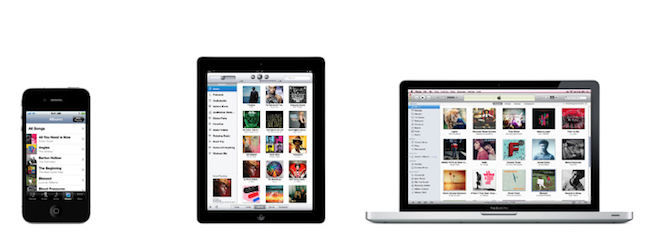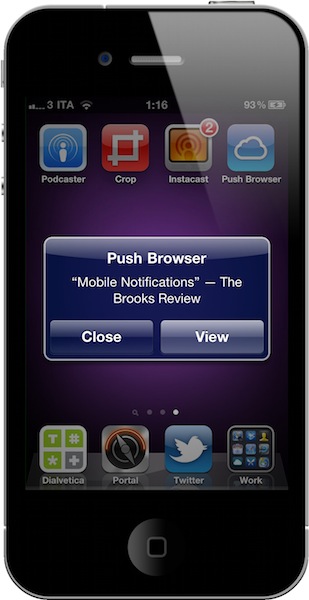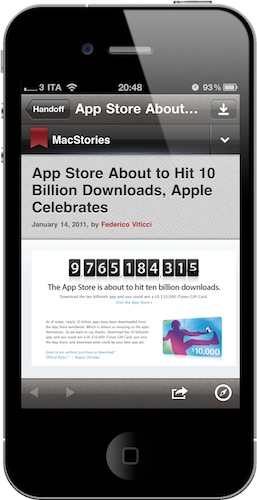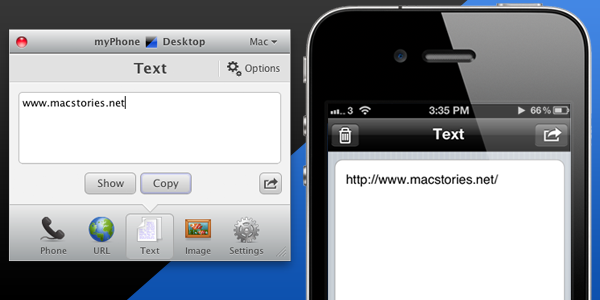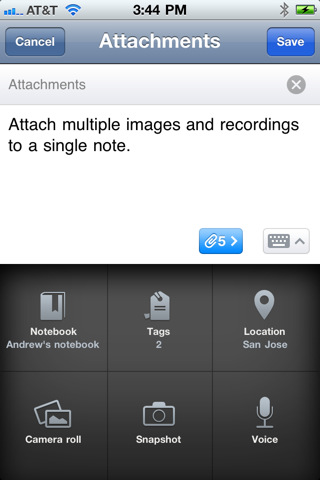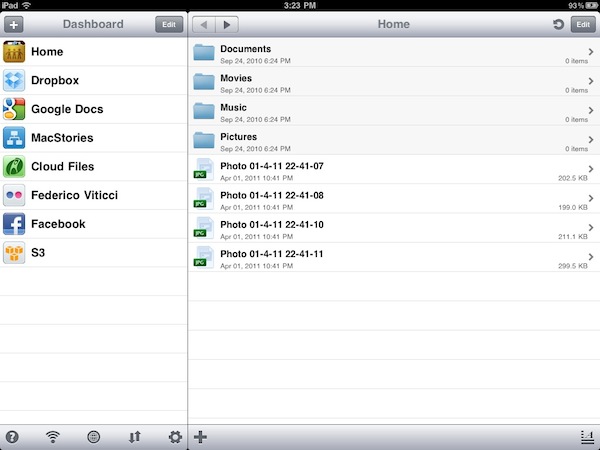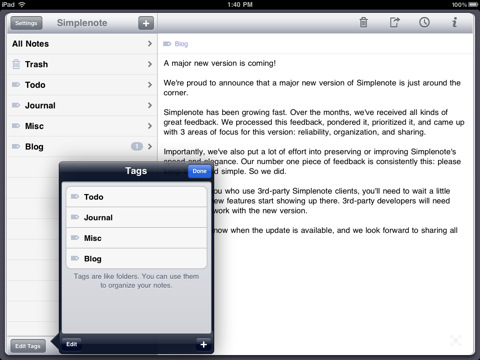Let’s face it, if you’re a Mac user who also happens to have an iPhone, iPad, or both, chances are you’ve been there before: with two devices in hand and a computer on your desk, how do you share stuff between them? What are the apps that enable you to share content across different devices, simultaneously and perhaps over the Internet as well?
In this post I’ve collected 10 iOS apps that are making my workflow more streamlined and connected on a daily basis, but before I delve deeper into the list I think I should define the “content” from this page’s title and the kind of “stuff” I want (and need) to share. With Lion approaching its final release in July and iCloud set to deliver a state-of-the-art OTA experience for users and developers alike, it seems like Apple has taken the necessary steps to free iOS devices from the need of a cable, building new features aimed at easing the process of sharing content between different machines and devices. Take Lion as an example: AirDrop, a new menu baked into the Finder, will allow Mac users to easily share files and documents with computers (and thus friends) nearby, over a WiFi network. Or, perhaps more importantly, the new iCloud APIs with instant push and cross-platform sync will enable developers to build better applications that take advantage of the cloud to keep their data synced and always up to date with the most recent changes. Whilst services and apps have been syncing content through their own backends for years, it’s the promise of a free iCloud infrastructure from Apple that’s convincing developers to ditch third-party solutions like Dropbox to rewrite their software with iCloud in mind. We’ll see the first result in September.
So what’s the content to share? What’s the stuff I find myself needing to share across devices every day? Links, photos, screenshots, PDFs, notes – you name it: as OS X and iOS become more intertwined on each software update, data needs to easily get out from one app to another. And in spite of an iCloud on the horizon, there hasn’t been a universal solution to share anything between a Mac and an iPhone.
In this article, I take a look at 10 iOS apps and services with some sort of Mac counterparts that have helped me over the past months in getting data out of my iPad and iPhone, and onto my MacBook Pro, iMac, and the cloud in general.
Push Browser
Unlike all those apps and services that allow you to beam a webpage from your desktop computer to an iOS device, Push Browser does quite the opposite: it installs as a Chrome extension (still no support for Safari and Firefox) and lets your computer receive links from an iOS device like the iPhone and iPad. So say you’re on the go and you need to check out an article later on your iMac, you don’t need to email it to yourself or save it in Instapaper: Push Browser enables you to do the most obvious thing, which is remotely opening a new tab in your Chrome browser. The app can receive webpages from a computer, too, but its biggest selling point is the capability of remotely sending a webpage from iOS to the Mac. You can download Push Browser for iPhone at $1.99 on the App Store, whilst the iPad version is a separate download.
Our review here.
Handoff
Of all the apps to receive a webpage on iOS through a push notification, Handoff is undoubtedly the best one to date. Not only it looks great both on the iPhone and iPad, it’s also got a series of extensions and bookmarklets for any desktop browser, it’s reliable and smart enough in the way it recognizes webpages from, say, other destinations like Google Maps. With the click of a button on your computer, a webpage will be instantly sent to your iOS device through Handoff. Because the iOS app is deeply integrated with other applications from third-party developers, you’ll be able to send the webpage you received to other browsers like iCab, Mercury, as well as apps like Pastebot and Instapaper. Handoff is universal and available at $1.99 on the App Store.
Our review here.
Send2Mac
Here’s another utility to send webpages from iOS to the Mac, no matter if you’re on WiFi and on a local network or on 3G. Unlike Push Browser and Handoff mentioned above, Send2Mac is free and comes as a browser bookmarklet. Send2Mac’s biggest advantage is that it works out of the box with any Mac browser, as the app installs as a background daemon that, through a unique API key for each of your Macs, will monitor the Internet for upcoming links to your computer. When a link from iOS (or any other device) arrives, it opens as a new tab in the system’s default browser. Send2Mac is fast, easy to use and free. The Mr. Reader iPad RSS client is a great example of apps supporting the Send2Mac API for sharing links between iOS and OS X.
Our review here.
myPhoneDesktop
myPhoneDesktop may look like a simple alternative to Handoff, but in reality this app is aimed at doing so much more than sharing links between devices. With desktop and web clients, myPhoneDesktop can send any kind of content from a computer to an iPhone or iPad: text, links, images, phone numbers, email addresses, Google Maps links – anything you can highlight in a web browser or on your desktop will likely be compatible with myPhoneDesktop. On the iPhone, the app can then forward the content it received to other compatible apps such as Safari or alternative browsers, or display it inline. myPhoneDesktop is quite possibly the most powerful solution to send various types of content to iOS devices, and it’s available as a Universal app at $4.99.
Our review here.
Pastebot
Tapbot’s famous utility is a must-have when it comes to having a unified clipboard that lives both your computer and iPhone. Besides letting you aggregate content from the iOS clipboard when the app runs in the background (for as long as 10 minutes, then you’ll have to re-launch it), Pastebot also comes with a Mac counterpart that lets the iPhone and OS X device communicate to share clipboard contents such as text, images, documents, and more. Pastebot has got a delicious user interface design, and I look forward to having a native iPad version with (just speculating here) iCloud sync someday. You can download Pastebot for iPhone at $3.99.
Our review here.
Evernote
Evernote is perhaps the most popular service to share any kind of content between iOS, Mac, Windows, Android, and the web browser. With a growing userbase and native apps for almost any platform out there (including recent additions such as an official Windows Phone 7 app and a great app for Android Honeycomb tablets), Evernote lets you snap pics on your iPhone and enter notes, save PDF documents, capture webpages or portions of them on your desktop, organize documents in tags and notebooks. Evernote is a digital capturing tool that wants to be the anything bucket always in sync thanks to the power of the cloud and cross-platform access. I use Evernote (with a Premium account) on a daily basis, and I love it. If anything, I’d love to see a major UI revamp for the iPad app (much needed after one year of availability) and possibility of editing rich-text notes on iOS devices.
Evernote is a free download on the App Store.
Scotty
I love this app. Previously known as Photo To Mac, Scotty lets you send iPhone photos and screenshots from your device to a Mac on the same local network. If your Mac has file sharing enabled, Scotty will be able to log in with your credentials, let you pick a shared folder, choose the photos, and send. This is perfect for writers like me, constantly sharing screenshots of applications between the iPhone and Mac, but it’s also a great solution for people willing to import photos without using the cable and iPhoto. Scotty is a very powerful app (it also works with AirPort Disks) and it can be downloaded at $1.99.
Our review here.
iFiles
For a very long time, iFiles has been my only way of sharing screenshots between iOS and the Mac: with its built-in WebDAV server and Bonjour support, I was able to import any image from the camera roll onto iFiles’ library, and then copy it to my desktop using either Transmit or Cyberduck. As time went by, however, I’ve come to appreciate all the other features of iFiles: Amazon S3 and Rackspace Cloud Files read/write access, CloudApp and Dropbox integration, built-in web browser and download manager. Still, iFiles remains a great way to share photos and documents with a Mac and, cloud service integration aside, you should consider it even if you’ve just been looking for a way to easily moves files across your OS X and iOS devices. iFiles is Universal and a $3.99 download.
Our review here.
Simplenote
Simplenote is the app that revolutionized my note-taking workflow. Taking notes on an iOS device used to involve Apple’s Notes application, spotty MobileMe sync (when available) and, for those who really couldn’t stand Apple’s Market Felt-based app, emailing notes to yourself because it was a simple, yet annoying solution. Simplenote changed that. Built with the cloud and iOS devices in mind, Simplenote is blazing fast, works anywhere and it syncs text in real-time. Simplenote has got a beautiful web app to view, edit, and share your notes, Dropbox integration to further backup your notes somewhere else, clean and stable iOS clients to quickly jot down what you need to remember or access later. Furthermore, the API built by Simperium allows other developers, such as the guys behind Notational Velocity, to plug into the service and display notes on the desktop, too. The Simplenote app is free in the App Store, and you can unlock a Premium account as in-app purchase at $19.99 per year to enjoy great features like the aforementioned Dropbox sync, list view on iOS and RSS feeds.
Our review here.
Dropbox
The king of file sharing utilities, a blog post about content shared across iOS and OS X wouldn’t be complete without Dropbox. Rather than telling you what Dropbox does (seriously, who doesn’t have an account or has at least heard of Dropbox nowadays?), here’s what I’d like to see from future updates to the iOS client: live streams for uploads, better handling of photo uploading and metadata, an improved iPad user interface and a serious text editor for all those documents I sync back to Dropbox using Simplenote. The official Dropbox app is free and you can download it here.


